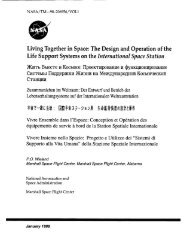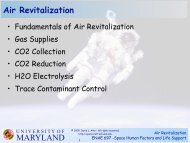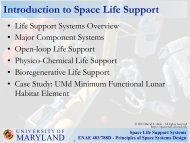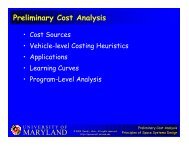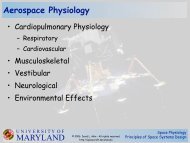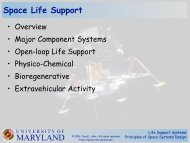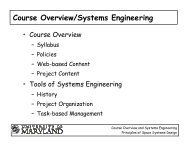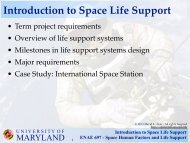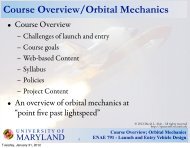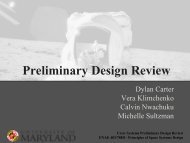MARYLAND Structural Design
MARYLAND Structural Design
MARYLAND Structural Design
You also want an ePaper? Increase the reach of your titles
YUMPU automatically turns print PDFs into web optimized ePapers that Google loves.
<strong>Structural</strong> <strong>Design</strong><br />
• Loads and Load Sources<br />
– <strong>Design</strong>ing or Critical Loads<br />
– Load Information / Estimation<br />
• Piece Parts Analysis<br />
– Margin of Safety Definition<br />
– Factors of Safety to use<br />
– Summary Table<br />
• Important <strong>Structural</strong> Concepts<br />
– Primary/Secondary Structure<br />
– Failsafe & Fracture Critical Structure<br />
– Aerospace Materials<br />
– <strong>Structural</strong> Failure<br />
U N I V E R S I T Y O F<br />
<strong>MARYLAND</strong><br />
<strong>Structural</strong> <strong>Design</strong> and Analysis<br />
Principles of Space Systems <strong>Design</strong>
Loads<br />
• "<strong>Design</strong>ing Load" is the load that determines one or<br />
more structural characteristic of the part:<br />
– shape, thickness, strength, stiffness, material...<br />
• Critical Load (somewhat synonymous) is more exactly<br />
the load that gives the minimum margin of safety (MS)<br />
for a part<br />
– MS represents the amount of extra structural capability you<br />
have over the applied load (elbow room)<br />
• Examples of Critical Loads<br />
– pressurization loads for a rocket casing<br />
– launch loads for a spacecraft<br />
– thermal loads for a propulsion subsystem<br />
– crash loads for a car<br />
U N I V E R S I T Y O F<br />
<strong>MARYLAND</strong><br />
<strong>Structural</strong> <strong>Design</strong> and Analysis<br />
Principles of Space Systems <strong>Design</strong>
Load Sources<br />
• Where do these loads come from?<br />
• For every part (subsystem) in your design, you should<br />
review every phase of its life and identify all loads that<br />
have the potential to be critical:<br />
– manufacturing & assembly<br />
– test (qualification, proof test)<br />
– transportation (truck or launch)<br />
– operation<br />
– contingencies (crash landing)<br />
• Obtain or estimate loads<br />
– look up loads in reference books<br />
– ask other groups to determine loads<br />
– guestimate for the purposes of starting analysis<br />
• Calculate all margins of safety<br />
U N I V E R S I T Y O F<br />
<strong>MARYLAND</strong><br />
<strong>Structural</strong> <strong>Design</strong> and Analysis<br />
Principles of Space Systems <strong>Design</strong>
Launch Vehicle Loads<br />
• Max Q - Aerodynamic Loads<br />
–Q = ρ V 2 / 2<br />
– maximum pressure and bending on vehicle<br />
• Max g's<br />
– usually occurs at stage burnout<br />
– maximum axial load on vehicle and payload<br />
• Abrupt environmental & vehicle changes<br />
– internal and external pressure drop<br />
– dramatic thermal changes<br />
• Staging shock loads<br />
– high g's, high frequency<br />
• Random vibration and acoustics<br />
– equiv. g's = sqrt (π PSD f n Q / 2)<br />
• Some of these loads apply to payload as well<br />
U N I V E R S I T Y O F<br />
<strong>MARYLAND</strong><br />
<strong>Structural</strong> <strong>Design</strong> and Analysis<br />
Principles of Space Systems <strong>Design</strong>
Launch Vehicle Failures<br />
• LV failures are tied to the following subsystems<br />
– Propulsion (70%)<br />
– Avionics (11%)<br />
– Separation (8%)<br />
– Electrical (7%)<br />
– <strong>Structural</strong> (2%)<br />
• <strong>Structural</strong> Failure Relatively Rare<br />
– AmRoc, Shuttle, Pegasus<br />
• Propulsion or Control System Failure More Common<br />
– Conestoga, LLV, Ariane V<br />
U N I V E R S I T Y O F<br />
<strong>MARYLAND</strong><br />
<strong>Structural</strong> <strong>Design</strong> and Analysis<br />
Principles of Space Systems <strong>Design</strong>
Spacecraft On-Orbit Loads<br />
• Accelerations<br />
– orbital accelerations<br />
– gravity gradient<br />
– spinning<br />
– on-board disturbances<br />
– thrusting (attitude control, reboost)<br />
• Thermal Loads<br />
– sun / shadow thermal gradients<br />
– eclipse effects (thermal snap)<br />
• Other Special Cases<br />
– EVA loads (corners & edges)<br />
– rendezvous & docking<br />
• Generally spacecraft are designed by launch loads!<br />
U N I V E R S I T Y O F<br />
<strong>MARYLAND</strong><br />
<strong>Structural</strong> <strong>Design</strong> and Analysis<br />
Principles of Space Systems <strong>Design</strong>
Planetary Vehicle Loads<br />
• Vibration loads from traversing rough terrain<br />
• Launch / landing loads<br />
• Maneuvering loads<br />
– tight turn<br />
– driving on an incline<br />
– loosing traction / support on one wheel<br />
• Crash loads<br />
– driving into a big boulder<br />
– rolling vehicle in unstable soil<br />
– safety is primary consideration<br />
U N I V E R S I T Y O F<br />
<strong>MARYLAND</strong><br />
<strong>Structural</strong> <strong>Design</strong> and Analysis<br />
Principles of Space Systems <strong>Design</strong>
Piece Parts Analysis<br />
• <strong>Structural</strong> analysis of a system consists of at least<br />
the following three tasks<br />
– Load Cycle Modeling (system-level) - iterative process<br />
– Piece-Part Analysis (static) - minimum margins of safety<br />
– Fracture and Fatigue Analysis (dynamic) - safe life<br />
analysis<br />
• Piece Parts Analysis<br />
– Identify all loads on each part / subsystem<br />
– Calculate margins of safety<br />
– Tabulate minimum margins of safety<br />
• Example: OTD Boom Piece Parts Analysis<br />
U N I V E R S I T Y O F<br />
<strong>MARYLAND</strong><br />
<strong>Structural</strong> <strong>Design</strong> and Analysis<br />
Principles of Space Systems <strong>Design</strong>
Factors & Margins of Safety<br />
• Limit Loads: maximum loads expected (applied loads)<br />
• Yield Load and Ultimate Load<br />
• Factors of Safety : numbers imposed by the Customer<br />
(or your own good sense) that reflect<br />
how uncertain you are of the load or structure<br />
how safe you want to be<br />
examples: 10 for bridges, 5 for ground handling equip, 2 for a/c<br />
• Margins of Safety are calculated as follows:<br />
MS<br />
• Beware: There are other definitions of these terms in engineering, but the<br />
above approach is the most common in Aerospace<br />
U N I V E R S I T Y O F<br />
<strong>MARYLAND</strong><br />
Allowable Load<br />
= − 10 .<br />
Applied Load x FS<br />
<strong>Structural</strong> <strong>Design</strong> and Analysis<br />
Principles of Space Systems <strong>Design</strong>
Primary Structure<br />
• Primary, Secondary, & Tertiary Structure<br />
– Primary structure is the system's backbone (carries all of<br />
the major loads imposed on vehicle)<br />
– Secondary structure includes all essential appendages and<br />
support structures (such as solar arrays, antennas, & fuel<br />
tanks)<br />
– Tertiary structures are less-essential mounting hardware<br />
(brackets, component housings, connector panels)<br />
• Example of primary structure<br />
– Thin-walled cylindrical launch vehicle<br />
– Challenge is to figure out how to react shear & torsion<br />
stresses<br />
– Buckling of skin is most common failure mode<br />
– Buckling of a cylindrical section:<br />
σ crit = E t / R sqrt [3(1-ν 2 )]<br />
U N I V E R S I T Y O F<br />
<strong>MARYLAND</strong><br />
<strong>Structural</strong> <strong>Design</strong> and Analysis<br />
Principles of Space Systems <strong>Design</strong>
Critical Structure<br />
• Critical Items List (CIL) contains all parts that<br />
– are deemed criticality 1 by FMEA (ie, single point failures)<br />
– are fracture critical (ie, stressed to the point where a flaw will grow to<br />
critical size)<br />
• Failsafe & Fracture Critical Structure<br />
– Catastrophic failure is generally defined by customer<br />
– Failsafe structure can take redistributed loads after failure (ie, not<br />
single point failures); shall release no hazardous mass; shall not change<br />
dynamics significantly; shall have no fatigue problems<br />
– Low-risk structure is not primary structure; has only a remote<br />
possibility of failure; will not propagate a crack in 4 lifetimes<br />
σ max < F tu / [ 4 (1-0.5 R) K t ]<br />
– Fracture critical parts must be labeled and analyzed as such, then<br />
inspected, treated, and tracked more carefully than conventional parts<br />
• Crack Growth Analysis (FLAGRO)<br />
– All FC parts must be shown good for four lifetimes of load cycles with an<br />
initial flaw (determined by NDI)<br />
U N I V E R S I T Y O F<br />
<strong>MARYLAND</strong><br />
<strong>Structural</strong> <strong>Design</strong> and Analysis<br />
Principles of Space Systems <strong>Design</strong>
Aerospace Materials<br />
• Comparison of specific stiffness, specific<br />
strength, and buckling parameter for a variety of<br />
aerospace metals and composites<br />
• Definition of <strong>Structural</strong> Failure<br />
– Detrimental Yield vs Textbook Yield<br />
• deformation that detrimentally affects functionality of<br />
system<br />
• 0.2% Tresca yield condition (assumes system linear in<br />
first place)<br />
– Ultimate Failure<br />
• any material rupture or loss of functionality<br />
U N I V E R S I T Y O F<br />
<strong>MARYLAND</strong><br />
<strong>Structural</strong> <strong>Design</strong> and Analysis<br />
Principles of Space Systems <strong>Design</strong>
Material Strength & Stiffness<br />
• Typical Yield & Ultimate Strengths<br />
– aluminum yld: 37 ksi ult: 42 ksi<br />
– low strength steel yld: 36 ksi ult: 58 ksi<br />
– high strength steel yld:102 ksi ult:116 ksi<br />
– Titanium yld:134 ksi ult:145 ksi<br />
• Stiffness versus Strength <strong>Design</strong>s<br />
– aluminum w: 0.10 E/w: 100 σ u /w: 420<br />
– Low σ u steel w: 0.28 E/w: 102 σ u /w: 204<br />
– high σ u steel w: 0.29 E/w: 98 σ u /w: 390<br />
– titanium w: 0.16 E/w: 109 σ u /w: 906<br />
Conclusion: for aerospace structures - titanium and<br />
aluminum<br />
U N I V E R S I T Y O F<br />
<strong>MARYLAND</strong><br />
<strong>Structural</strong> <strong>Design</strong> and Analysis<br />
Principles of Space Systems <strong>Design</strong>
<strong>Structural</strong> Analysis<br />
• Some key structural formulas that are handy to<br />
have for early (back-of-the-envelope) design<br />
analyses:<br />
– Spring & Beam Stiffnesses<br />
– Beam Natural Frequencies<br />
– Euler Buckling Loads<br />
– Stresses in Simple Pressurized Shell<br />
σ hoop = p R / t ; σ long = p R / 2 t<br />
– Random Vibe and Acoustic Equivalent g's<br />
U N I V E R S I T Y O F<br />
<strong>MARYLAND</strong><br />
<strong>Structural</strong> <strong>Design</strong> and Analysis<br />
Principles of Space Systems <strong>Design</strong>
<strong>Structural</strong> Analysis<br />
• Definition of Example Problem<br />
• Definition of Load Cases<br />
• Analysis of Stresses<br />
• Tabulation of Margins of Safety<br />
• Identification of Critical Load Case<br />
U N I V E R S I T Y O F<br />
<strong>MARYLAND</strong><br />
<strong>Structural</strong> <strong>Design</strong> and Analysis<br />
Principles of Space Systems <strong>Design</strong>
<strong>Structural</strong> Example<br />
U N I V E R S I T Y O F<br />
<strong>MARYLAND</strong><br />
• Storage canister for<br />
ISS solar array<br />
deployment system<br />
• 200 lb tip mass<br />
• Cantilever launch<br />
configuration<br />
• Thin-wall aluminum shell<br />
structure<br />
<strong>Structural</strong> <strong>Design</strong> and Analysis<br />
Principles of Space Systems <strong>Design</strong>
Loads Sources<br />
U N I V E R S I T Y O F<br />
<strong>MARYLAND</strong><br />
• Launch<br />
– Accelerations<br />
– Pressurization<br />
– Acoustics<br />
– Random Vibration<br />
– Thermal<br />
• Crash Landing<br />
• On-Orbit<br />
<strong>Structural</strong> <strong>Design</strong> and Analysis<br />
Principles of Space Systems <strong>Design</strong>
<strong>Structural</strong> Parameters<br />
E = 1× 10 psi<br />
7<br />
α<br />
−<br />
= 13 × 10<br />
⋅°<br />
6 R= 25 in l = 100 in t = 010in<br />
π<br />
I = ( 4 4<br />
Ro −R<br />
) i ≅ π<br />
3 4<br />
R t = 4800 in<br />
4<br />
lbs<br />
ρ = 010 . 3<br />
in<br />
in<br />
in F<br />
.<br />
Wcanister = 2πρtRl = 157 lbs Wtip = 200 lbs<br />
g<br />
in<br />
= 386 4 2<br />
. sec<br />
U N I V E R S I T Y O F<br />
<strong>MARYLAND</strong><br />
σ Ty<br />
= 37 ksi σ Tu = 42 ksi<br />
A= 2 Rt = 1571in 2<br />
π .<br />
<strong>Structural</strong> <strong>Design</strong> and Analysis<br />
Principles of Space Systems <strong>Design</strong>
Launch Accelerations<br />
±4.85 g<br />
U N I V E R S I T Y O F<br />
<strong>MARYLAND</strong><br />
±5.8 g<br />
±8.5 g<br />
FOS = 14 .<br />
MR W<br />
σ<br />
tip<br />
LA<br />
x<br />
I A g<br />
= +<br />
M = g W h + W h<br />
( )<br />
transverse canister CG tip tip<br />
2 2<br />
gtransverse = 58 . + 85 . = 103 . g<br />
M = 10. 3( 157⋅ 50 + 200 ⋅100)<br />
= 286, 900 in⋅lb ( 286900inlb)( 25in)<br />
200lb<br />
σ LA = + 485 .<br />
4 2<br />
4800in<br />
15. 71in<br />
σ LA = 1494 + 61. 75 = 1556 psi<br />
<strong>Structural</strong> <strong>Design</strong> and Analysis<br />
Principles of Space Systems <strong>Design</strong>
Pressurization Loads<br />
σ Hoop<br />
U N I V E R S I T Y O F<br />
<strong>MARYLAND</strong><br />
FOS = 30 .<br />
PR ( 14. 7psi)( 25in)<br />
= = = 3675<br />
t 01 . in<br />
PR<br />
σ Longitudinal = = 1838<br />
psi<br />
2t<br />
psi<br />
<strong>Structural</strong> <strong>Design</strong> and Analysis<br />
Principles of Space Systems <strong>Design</strong>
Launch Vehicle Vibration Environment<br />
Power Spectral Density<br />
(g 2 /Hz)<br />
U N I V E R S I T Y O F<br />
<strong>MARYLAND</strong><br />
1<br />
0.1<br />
0.01<br />
0.001<br />
Frequency (Hz)<br />
1 10 100 1000 10000<br />
<strong>Structural</strong> <strong>Design</strong> and Analysis<br />
Principles of Space Systems <strong>Design</strong>
Random Vibration Loads<br />
RLF<br />
f<br />
=<br />
n<br />
fnPSD = π<br />
4ξ<br />
U N I V E R S I T Y O F<br />
<strong>MARYLAND</strong><br />
FOS = 30 .<br />
1. 732 EIg<br />
2π W l + 0. 236W<br />
l<br />
1 3 3<br />
tip canister<br />
fn<br />
300 Hz .005<br />
ξ<br />
=<br />
80<br />
Hz<br />
RLF = 793 . g<br />
M = 220, 700 in ⋅lbs<br />
MR<br />
σ RV = =1150<br />
psi<br />
I<br />
(repeat for each axis)<br />
<strong>Structural</strong> <strong>Design</strong> and Analysis<br />
Principles of Space Systems <strong>Design</strong>
Thermal Loads<br />
U N I V E R S I T Y O F<br />
<strong>MARYLAND</strong><br />
FOS = 14 .<br />
∆l= α ⋅∆T⋅l −6<br />
∆l = 13 × 10 ⋅− 100° F⋅ 100 = . 13 in<br />
Assume support structure shrinks only half as<br />
much as canister<br />
σ ε<br />
7 . 5× . 13<br />
Thermal = E = 10 ⋅ = 6500 psi<br />
100<br />
<strong>Structural</strong> <strong>Design</strong> and Analysis<br />
Principles of Space Systems <strong>Design</strong>
Launch Loads Summary<br />
MS<br />
U N I V E R S I T Y O F<br />
<strong>MARYLAND</strong><br />
Load Source Limit<br />
Stresses<br />
Launch<br />
Accelerations<br />
FOS <strong>Design</strong><br />
Stress<br />
1556 1.4 2178<br />
Pressurization 3675 3.0 11,025<br />
Random<br />
Vibration<br />
1150 3.0 3450<br />
Thermal 6500 1.4 9100<br />
Total 25,750 psi<br />
Allowable Load 37, 000<br />
= − 1 = − 1= 43.% 7<br />
<strong>Design</strong> Load 25, 750<br />
<strong>Structural</strong> <strong>Design</strong> and Analysis<br />
Principles of Space Systems <strong>Design</strong>
Observations about Launch Loads<br />
• Individual loads could be applied to same<br />
position on canister at same times -<br />
conservative approach is to use<br />
superposition to define worst case<br />
• 43% margin indicates that canister is<br />
substantially overbuilt - if launch loads<br />
turn out to be critical load case, redesign<br />
to lighten structure and reduce mass.<br />
U N I V E R S I T Y O F<br />
<strong>MARYLAND</strong><br />
<strong>Structural</strong> <strong>Design</strong> and Analysis<br />
Principles of Space Systems <strong>Design</strong>




